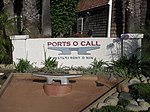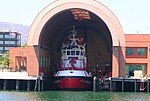Harbor Boat Building Company
1940s in CaliforniaAmerican Theater of World War IIAmerican boat buildersSource attribution

Harbor Boat Building Company was a shipbuilding company on Terminal Island in San Pedro, California. To support the World War II demand for ships General Engineering built: minesweepers, torpedo boats, submarine chasers, and air-sea rescue boats. In 1919 Romolo Rados founded Harbor Boat Building. After the war he renamed the company Harco Shipyard and built and sold a standard design motor boat. In 1959 he sold the company to LTV. The shipyard was closed and the company was sold again in 1971 to Omega-Alpha, Inc. The last ship built was in 1965 for the US Navy. The shipyard was located at 263 Wharf St, San Pedro.
Excerpt from the Wikipedia article Harbor Boat Building Company (License: CC BY-SA 3.0, Authors, Images).Harbor Boat Building Company
Wharf Street, Los Angeles
Geographical coordinates (GPS) Address Nearby Places Show on map
Geographical coordinates (GPS)
| Latitude | Longitude |
|---|---|
| N 33.738035 ° | E -118.267862 ° |
Address
Wharf Street 217
90731 Los Angeles
California, United States
Open on Google Maps









